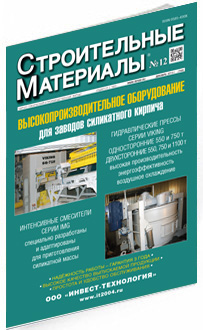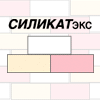Stroitel`nye Materialy №12

December, 2013
Table of contents
A.A. SEMENOV, Candidate of Technical Sciences, General Director, OOO “GS-Expert” (Moscow)
The characteristic of existing capacities for producing silicate brick is made; it is shown that over 78% of all silicate enterprises manufacturing about 72% of the total volume of production are concentrated in the Volga and Central Federal Districts. It is also shown that the industry has not yet reached the pre-crisis levels, but shows a steady growth of production, amounting to 5-8% per year. The share of large-size blocks and solid thickened brick is gradually increasing in the commodity structure. The share of silicate brick in the total volume of piece wall materials is approximately evaluated in 22%. The prognosis about reaching the production performance of the pre-crisis level in 2017 in case of favorable development of the economic situation is made.
G.V. KUZNETSOVA, Associate Professor, N.N. MOROZOVA, Candidate of Technical Sciences, Associate Professor, Kazan State University of Architecture and Civil Engineering
The crushed construction sand as an acidic corrective additive in the structure of calcareous-siliceous binder influences on the mineralogical composition of the binder, time and temperature of its slaking. The obtained regularity makes it possible to indirectly control the slaking time of lump lime.
Key words: calcareous-siliceous binder, crushed sand, lime, temperature of lime slaking, time of lime slaking.
V.A. VOYTOVICH, Candidate of Technical Sciences, Deputy General Director, Nizhny Novgorod Regional Center of Nanoundustry; I.N. KHRYAPCHENKOVA, A.A. YAVORSKY, Candidates of Tecnical Sciences, Nizhny Novgorod State University of Architecture and Civil Engineering
Hydrophobization as a Method of Improving the Lifetime of Buildings
This article attracts attention to the necessity of the more wide use in construction of hydrophobisators, substances which at low cost make it possible to improve appreciably the durability of reinforced concrete and brick building materials, reduce their heat conductivity, prevent the formation of icing and icicles, improve sanitary-hygienic characteristics in dwellings, reduce expenditures for maintenance of buildings. Key words: protection of structures surfaces, hydrophobization, organosilicon hydrophobisators, “lotus effect”.
This article attracts attention to the necessity of the more wide use in construction of hydrophobisators, substances which at low cost make it possible to improve appreciably the durability of reinforced concrete and brick building materials, reduce their heat conductivity, prevent the formation of icing and icicles, improve sanitary-hygienic characteristics in dwellings, reduce expenditures for maintenance of buildings. Key words: protection of structures surfaces, hydrophobization, organosilicon hydrophobisators, “lotus effect”.
I.M. BARANOV, Candidate of Technical Sciences, OOO “NTTS EMIT” (Moscow)
The justification of necessity for elaborating recommendations on the operative selection of rational compositions of special concretes available for factory laboratories is offered to be discussed.
Key words: multi-component concretes, methods of designing concrete compositions, additives to concretes.
A.V. ANTSYBOR, engineer, M.I. BRUSSER, Candidate of Technical Sciences, Scientific and Research Institute for Concrete and Reinforced Concrete named after A.A. Gvozdev (Moscow)
New methods for determining strength properties of concretes including the super high-strength in the course of the test on tension at cleaving of small-size samples of cylinders are presented. The distinctive feature is the possibility with high discreteness of the step along the depth of the structure section to determine the heterogeneity of strength characteristics, including in densely reinforced structures. Examples of obtained diagrams of quantitative changes of strength characteristics along the section of the floor slab are presented. Results of conducted experimental studies satisfy the requirements of the operating standard for homogeneity (uniformity) of the conversion factors obtained. Testing methods can be used by scientific, design and surveying organizations, research laboratories and engineering companies for determining and evaluating the operation reliability and suitability of concrete and reinforced concrete structures and products.
Key words: kerns, concrete strength, heterogeneity of strength along the section of structure.
V.P. SELYAEV, Doctor of Technical Sciences, Academician of RAACS, V.A. NEVEROV, Candidate of Physical-Mathematical Sciences, L.M. OSHKINA, P.V. SELYAEV, Candidate of Technical Sciences, E.V. SOROKIN (ntorm80@mail.ru), E.L. KECHUTKINA(ntorm80@mail.ru), engineer-builders, N.P.Ogarev Mordovia State University (Saransk)
Results of the study of regularities of changes of strength and sorption properties of cement concrete during the process of sulfate corrosion are presented. It is established that as a result of interaction of an aggressive medium with concrete, three zones of degradation – latent, active and zero – are formed. For the first time, the regularities of changes of elastic-strength properties of concrete along the cross-section height of a product in the course of simultaneous actions of force factors and water solutions of sulfuric acid are experimentally defined. Methods and formulas for determining basic parameters of degradation – the depth index, coefficient of advance speed of degradation front, coefficient of chemical resistance, concentration limit of the sorbed aggressive medium in the material – are offered.
Key words: corrosion, micro-hardness, isochrones of degradation, coefficient of diffusion, destruction front.
B.K. KARA-SAL, Doctor of Technical Sciences, D.Kh. SAT, L.E. KUULAR, engineers (silikat-tgu@mail.ru), Tuvan State University ( Kyzyl, The Tyva Republic)
The possibility to use the anthropogenic waste of zeolite-containing rock (siftings of crushing) in production of ceramic wall materials as an additive to the low-grade loam for intensification of mass sintering is shown. Chemical and mineralogical compositions of the Bii-Khem loam and zeolite-containing rock are presented. On the basis of laboratory and industrial tests at the operating brick factory it is proved that the addition of 20% of an zeolite-containing additive makes it possible to reduce the water absorption, improve the strength of burned products and also to reduce the quantity of defective goods due to improving forming properties of the mass.
Key words: loam, zeolite-containing rock, mass, burning, strength, water absorption, quality enhancement.
N.G. GUROV, General Director, ZAO “YuzhNIIstrom”; O.E. GUROVA, senior teacher, Rostov State Transport University (Rostov-on-Don); G.I. STOROZHENKO, Doctor of Technical Sciences, Director, OOO “Baskey” (Novosibirsk)
It is shown that the absence of sufficient quantity of high-quality clay raw materials for producing the building ceramic by plastic moulding conditions the prospects of development of semi-dry moulding technology. Main shortcomings of low-grade clay raw materials are clogging with carbonate inclusions and low plasticity. It is justified that for involving the low-grade raw material in production it is necessary to ensure its superfine grinding up to the class not more than 250 mcm with the following granulation of the powder obtained. Russian developments for fine grinding, mechanical activation and granulation of clay raw materials as well as for following moulding, drying and burning are described. It is concluded that comparing with the plastic method of moulding investments in production using the semi-dry method reduce by 1.4-1.6 time; raw materials base significantly expands; possibility for point reconstruction of operating enterprises of average power appears.
Key words: low-grade raw materials, carbonate inclusions, grinding, semi-dry pressing, surface energy, grinding-mixing plant, mechanical activation, granulation, multi-fraction powder, coefficient of moisture conductivity, modernization.
R.R. AKHTYAMOV, Head of Laboratory of Refractory Concretes, UralNIIstrom Institute (Chelyabinsk)
Different structural decisions of lining for baking trolleys of tunnel kilns are presented. Comparative characteristics of different types of refractory are presented; it is shown that unmoulded refractories on the basis of a slag-alkali binder have optimal complex of properties in the quality-price system. Technical characteristic of refractory concrete on the basis of a slag-alkali binder of improved thermo-resistance developed at UralNIIstrom is given; examples of industrial application at different brick factories are shown.
Key words: ceramic brick, tunnel kiln, baking trolley, moulded refractories, refractory concretes, slag-alkali binder, border blocks, canalized hearth
M.A. VYSOTSKAYA, D.A. KUZNETSOV, Candidate of Technical Sciences, Belgorod State Technological University named after V.G. Shukhov; D.E. BARABASH, Doctor of Technical Sciences, Air Force Military Educational and Scientific Center “Air Force Academy”(Voronezh)
The experience in modification of a polymer-bitumen binder with the use of single-shell carbonic nanotubes is considered. The problem of uniform distribution of nanotubes in the volume of a polymer additive and ways of its solving with the use of ultrasound are revealed. The possibility to obtain the efficient nanomodified polymer-bitumen binder with a wide range of operation temperatures is shown. Results of the study of asphalt concrete properties on the basis of the binder mentioned are presented.
Key words: nanotubes, polymer, modification, asphalt concrete
A.A. AKHREMENKOV, Candidate of Technical Sciences, Program Systems Institute named after A.K. Ailamazyan, RAS (Yaroslavl Oblast); V.A. KUZMIN, engineer, ZAO “LIT Works” (Pereslavl-Zalessky, Yaroslavl Oblast), A.M. TSIRLIN, Doctor of Technical Sciences, Program Systems Institute named after A.K. Ailamazyan(Yaroslavl Oblast); V.M. TSYGANKOV, Deputy General Director, ZAO “LIT Works” (Pereslavl-Zalessky, Yaroslavl Oblast)
A model of heat exchange is considered; the possibility for it to see the dependence of heat consumption as well as dependence of the coefficient of heat energy saving on the coefficient of enclosure blackness is determined. As the really existing example confirming in practice the reasonability of the use of this method of heat insulation, an industrial building of 10630 m³, enclosing structures of which are made of corrugated metal sheet and heat insulation is “penofol” of 10 mm thickness is presented. It is shown that the coating of inner surface of the enclosure makes it possible to save heat.
Key words: reflective heat insulation, heat transfer, heat exchange, heat energy saving.
A.Yu. VARFOLOMEEV, Candidate of Technical Sciences, OOO “Research Laboratory of Building Expertise of Barents Region” (Moscow)
It is shown that substandard counterfeit analogues of building materials lower the safety, reliability, durability, operation life, and use value of buildings and structures. Disadvantages of the existing Russian legislation in terms of countering the use of counterfeit products in the field of construction are revealed. The negative consequences of incorrect application of new building materials are considered on the example of glass-magnesite sheets (GMS) under the severe conditions of sub-arctic climate. A monitoring of accumulation of GMS damages under variable temperature-humidity conditions of operation of a building has been carried out. The peculiarities of GMS production, its specific properties, as well as the shortcomings of the domestic normative acts in the sphere of construction have been defined. The increase in the number of anthropogenic catastrophes in recent years leads to the necessity of tightening of the scientific and technical building control, including the more precise definition of relevant regulations.
Key words: counterfeit, glass-magnesite, GMS additives, boarding, sub-Arctic, deformation, damages.
A.A. PANINA, engineer(panina273@yandex.ru), A.V. KORNILOV, Doctor of Technical Sciences, T.Z. LYGINA, Doctor of Geological and Mineralogical Sciences, E.N. PERMYAKOV, Candidate of Technical Sciences, Central Research Institute for Geology of Industrial Minerals (Kazan)
It is established that the addition of disperse fillers (10-20% of siliceous rock containing zeolite and 10-15 % of wollastonite) activated in the regime of triboelectric generation of gas-dust plasma to the Portland-cement of M300 leads to improvement of its strength properties. Compression strength increases by 21-42%, bending strength – by 11-16%. This effect is caused, first of all, by the change of hydration process and optimization of the structure of cement stone.
Key words: wollastonite, zeolite-containing rock, activation of Portland-cement, energy efficiency.
S.A. VAVRENYUK, Doctor of Technical Sciences, Corresponding Member of RAACS, V.A. AVRAMENKO, Doctor of Chemical Sciences, Corresponding Member of RAS, A.V. ALIKOVSKY, Candidate of Chemical Sciences, V.Yu. MAYOROV, Candidate of Chemical Sciences, N.N. MIKHAYLOVA, engineer, Far-Eastern Research, Design and Technological Institute for Construction (DalNIIS) of RAACS (Vladivostok)
An analysis of the influence of non-functional organic silicone compounds on the process of clinker grinding in the course of obtaining cement powder is made. The possibility of using organic silicone compounds of non-functional type for three-phase modification of cement systems during the mechanical activation process is shown.
Key words: organic silicone compounds, clinker, grinding, intensification, specific surface, flocculation.
S.A. VAVRENYUK, Doctor of Technical Sciences, Corresponding Member of RAACS, Far-Eastern Research, Design and Technological Institute for Construction (DalNIIS) of RAACS (Vladivostok)
Results of the conductometric study concerning the influence of increased dosage of polyvinyl alcohol on the process of structure formation of cement stone are presented. It is shown that the system of interconnected (sedimentation) capillary pores is absent in the cement mortars with high water-cement ratio in the presence of additives of polyvinyl alcohol.
Key words: polyvinyl alcohol, water demand, cement mortar, structure formation, specific electrical resistance.
 |
 |
 |
 |
 |
 |

